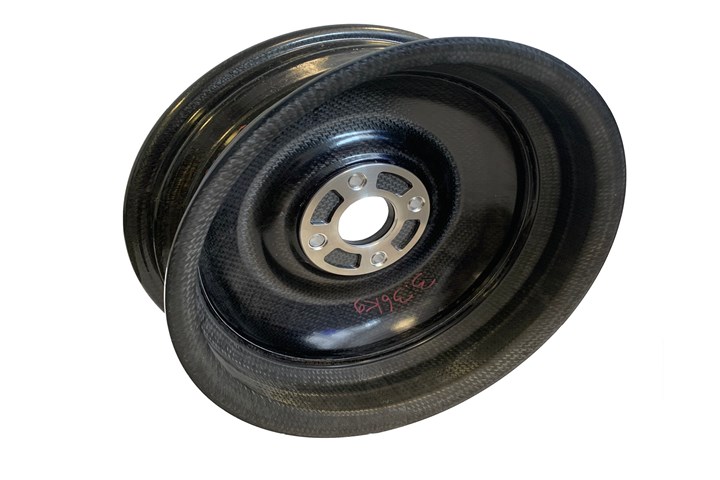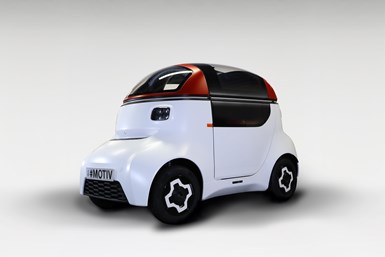All-composite EV wheel moves to next development phase
U.K. consortium partners’ ACRIM II project aims to develop a low-cost, lightweight, all-composite wheel for electric vehicle applications.

It was reported on March 9 that consortium partners Carbon ThreeSixty (Chippenham, U.K.), Far-UK (Nottingham, U.K.), Composite Integration (Cornwall, U.K.), CNC Robotics (Liverpool, U.K.) and Bitrez Ltd. (Standish, U.K.), have moved the ACRIM-Wheel — what is said to be first commercially viable, low-cost, lightweight, all-composite wheel for niche and electric vehicle (EV) applications — to the next phase of development, after its successful completion of the program’s second phase. The second phase, which involved development and validation of proof-of-concept, confirmed the design’s feasibility of achieving significant cost reductions over existing global market offerings. The consortium aims to manufacture fifty wheels by the end of 2020.
Further developments include three full vehicle sets, and two sets of overmolded RTM wheels which are headed for qualification testing. The vehicle sets are also to be tested on MOTIV, a versatile autonomous mobility vehicle using model design company Gordon Murray Design’s (Guildford, U.K.) iStream Superlight technology which approaches automotive production with vehicle lightweighting goals.
According to the partners, the work being undertaken will enable wider access to key lightweighting technologies for the lower volume niche automotive manufacturers. The product development consortium previously made a number of key findings, with a highlight being that the modular concept of ACRIM offers unrivalled flexibility in the styling and configuration of lightweight all-composite wheels. This puts it firmly on track to reduce the weight of, for example, a 15-inch wheel by 50%, which would deliver 5% fuel savings or a 5% CO2 reduction when retrofitted to a petrol- or diesel-fueled vehicle.

MOTIV autonomous vehicle platform
The ACRIM modular concept being applied to this project is said to enable the creation of wheels ranging from a “traditional” two-piece bolted metallic center with a composite barrel (mature, low risk architecture) through to an overmolded all-composite wheel.
The consortia contends that the demonstration of an SMC overmolded center into a continuous fiber RTM’d barrel offers early indication of high-volume capability and short route to manufacture. The ACRIM modular platform is also said to enable a tiered approach to OEMs in specifying lightweight wheels depending on their appetite for disruptive innovation.
For the next phase, which kicked off this past summer, the consortium aimed to decrease manufacturing cost and cycle time with a multi-strand approach. Avenues include processing of a three-component epoxy resin system with an in-mold release agent, piston pump technology to deliver repeatable and higher quality lamination through increased control and monitoring of the preconditioning of resin prior to injection (metering, mixing, pre-heating and degassing) and a mold pressure closed loop control system to improve yield.
The production scale-up project also aims to prove that robotic machining can be sufficiently accurate and repeatable for secondary machining over conventional machining tools, including trimming and drilling of composite components. This, the partners say, can offer fast and flexible operation that opens the door to reduced skilled labor content.
According to the partners, the product has been evolving as well. This includes the consortia’s optimization of the part’s design to minimum weight and cost with an automatic analysis of manufacturability, particularly CFD material flow. It also plans to prove the manufacturing robustness of the novel overmolding process for a high reliability structural component.
“The world’s first all-composite wheel for electric and niche vehicles has moved a major step forward, and we can confidently say it has the ability to deliver huge cost savings over anything on the market. It can also be manufactured in volume and gives OEMs huge flexibility in what they can specify. This is truly a quantum leap in wheel design and manufacture,” notes lead project partner, Edward Allnutt, managing director at Carbon ThreeSixty.
According to the consortia, previously seen to be purely performance driven for racing and high-performance applications, lightweight carbon wheels are now being investigated by electric and niche vehicles and OEMs to further reduce fuel consumption, emissions, extend vehicle range and increase payload.
Related Content
Creating a composite battery insert-stud solution for EV trucks
Bossard worked with an OEM and Tier supplier team to meet tight electrical insulation and packaging tolerances while reducing tooling, molding and assembly costs.
Read MoreCo-molding SMC with braided glass fiber demonstrates truck bed potential
Prepreg co-molding compound by IDI Composites International and A&P Technology enables new geometries and levels of strength and resiliency for automotive, mobility.
Read More“Structured air” TPS safeguards composite structures
Powered by an 85% air/15% pure polyimide aerogel, Blueshift’s novel material system protects structures during transient thermal events from -200°C to beyond 2400°C for rockets, battery boxes and more.
Read MoreTPI manufactures all-composite Kenworth SuperTruck 2 cab
Class 8 diesel truck, now with a 20% lighter cab, achieves 136% freight efficiency improvement.
Read MoreRead Next
Ultrasonic welding for in-space manufacturing of CFRTP
Agile Ultrasonics and NASA trial robotic-compatible carbon fiber-reinforced thermoplastic ultrasonic welding technology for space structures.
Read MoreNext-gen fan blades: Hybrid twin RTM, printed sensors, laser shock disassembly
MORPHO project demonstrates blade with 20% faster RTM cure cycle, uses AI-based monitoring for improved maintenance/life cycle management and proves laser shock disassembly for recycling.
Read MoreCutting 100 pounds, certification time for the X-59 nose cone
Swift Engineering used HyperX software to remove 100 pounds from 38-foot graphite/epoxy cored nose cone for X-59 supersonic aircraft.
Read More


























